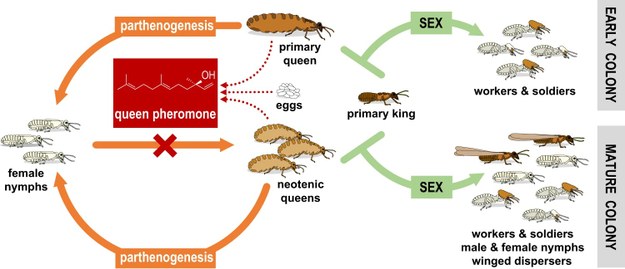Pheromones – more than a thousand words
Higher termites (family Termitidae) are the most diverse group of termites, comprising over 70% of all termite species. Unlike lower termites, they lack the specialised flagellate protozoa in their guts that are involved in the digestion of cellulose in lower termites. Nevertheless, higher termites can cope with the digestion of cellulose and their diet can be much more varied, including, for example, dirt. Higher termite colonies are usually ruled by a single king and queen. For some species, however, the situation is somewhat more complex. Their colony is founded by a primary queen, but she soon dies and is replaced by a sort of harem of neotenic queens (NQs) that arise through parthenogenesis. Parthenogenesis is a type of asexual reproduction in which an individual develops from an unfertilised egg; in this case, unfertilised eggs laid by the founder queen before her untimely death. These parthenogenetic eggs first develop into nymphs and then moult into NQs in response to the death of the founder queen. There may be up to several hundred of these in the resulting harem and they reproduce with the primary founder king. At the same time, they give rise asexually to further generations of NQs, which then complete the harem of queens. The systematic production of parthenogenetic NQs is thus the cornerstone of this unique reproductive strategy called asexual queen succession (AQS).
In her PhD thesis, K. Dolejšová in 2015 described the first AQS species of higher termites, which she and her collaborators discovered during research in the tropical forests of French Guiana. It was for this species (Embiratermes neotenicus) that she then asked the follow-up question: how do parthenogenetic nymphs know that the time is right to evolve into queens? Or alternatively, how do they know the moment when the founder dies? It is well established that the reproductive division of labour in advanced social insects is controlled by chemical signals emitted by the queen, generally referred to as royal pheromones. With these, the usually prolific queens inhibit the reproductive abilities of other females in the colony, thus securing their reproductive monopoly.
Despite the immense importance of royal pheromones, their chemical identity in termites remained unknown for a long time. The first, and for a long time the only known royal pheromone, was described in lower termites in 2010. Only now has our students' work on the higher termite E. neotenicus followed this up. Ten colonies native to the forests of French Guiana were obtained for the study. The results revealed that the sesquiterpene alcohol (3R,6E)-nerolidol (RNERO) released by queens into their environment inhibits the production of new NQs from parthenogenetic female nymphs. Conversely, under queen-free conditions or in the absence of RNERO, these nymphs respond by rapidly differentiating into new NQs. In this study, the researchers demonstrated that RNERO acts as an airborne signal while exhibiting a selective olfactory preference in nymphs. These results confirm that RNERO is only the second royal pheromone identified in termites to date and the first described in higher termites.
 A scheme of pheromone and genetic regulation in colonies of the termite E. neotenicus.
A scheme of pheromone and genetic regulation in colonies of the termite E. neotenicus.
The results of the study are therefore clear ‒ RNERO is a newly discovered queen termite pheromone that can inhibit the formation of new NQs from female nymphs. The queen uses it to secure her reproductive monopoly in the colony for the duration of her sexual and physical fitness. When her strength finally runs out, she can be replaced within a few days by a harem of parthenogenetic daughters who are genetically closely related to her. Similarly, the NQs in the harem themselves secrete RNERO and thus again regulate the number of newly emerging queens. The same function can be attributed to the RNERO secreted by the eggs, which are a direct indicator of queen fertility. Pheromonal control of the development of new parthenogenetic queens is a key regulatory element in the AQS reproductive system. The study also reveals that the two queen pheromones identified so far in termites have fundamentally different chemistry, suggesting that the range of these pheromone signals in termites, which are still awaiting discovery, may be unexpectedly diverse.
Tereza Žirovnická
Document Actions